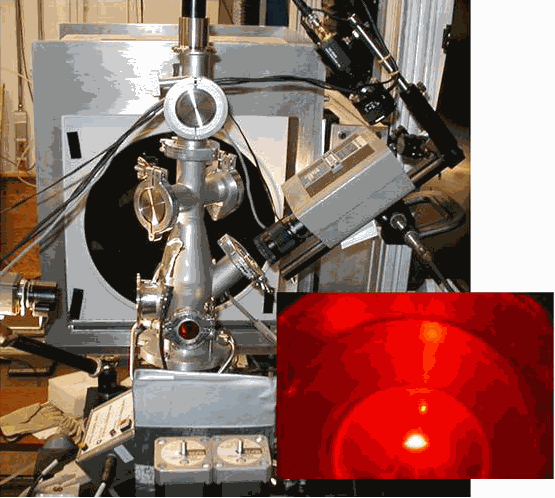Using temperatures approaching those found on the surface of the sun and intense x-ray beams from two synchrotron x-ray facilities, including the Advanced Photon Source at Argonne National Laboratory, researchers have been able to directly probe structural changes in refractory ceramic liquids over a wide range of length-scales. The team observed liquids separating into two different states – one lighter and more perfect than the other. This is the first time the phenomenon has been seen in any liquid at any temperature. The researchers expect this discovery, reported in the journal Science, to “have profound implications for understanding liquids in general, both at the high temperatures and pressures in the Earth’s metallic core, for example, or at room temperature in biological liquids,” according to Neville Greaves from Aberystwyth University, who led the research team.
Using a special laser heated furnace, the researchers from Aberystwyth, Ecole Nationale Supérieure de Chimie de Paris, Argonne, Materials Development, Daresbury Laboratory, and CNRS-CEMHTI melted aluminum yttrium oxide at temperatures approaching the surface of the sun, forming drops that were floated on a stream of gas. Scattered radiation from the Synchrotron Radiation Source at Daresbury (UK) revealed the liquids separating and then reforming as the temperature dropped below the melting point. When intense x-rays from the U.S. Department of Energy’s Advanced Photon Source were fired at the shimmering spheres, the team was able to probe the structure of the high temperature liquid in much more detail at the atomic level. This is the first time this phenomenon has been seen in any liquid at any temperature. A Nature Materials “news and views” article on the work by Paul McMillan suggests that these findings “will result in synthesis and design of new families of materials including nanocomposites.”
According to article co-authors Chris Benmore and Rick Weber (both of the Argonne X-ray Science Division), the researchers had extensive experience with laser-heated aerodynamic levitation techniques, having made structural measurements on a variety of materials from yttrium aluminum garnet, to molten lavas, to air-brazing alloys. The team used this experience to develop a laser-heated aerodynamic levitation furnace for x-ray scattering experiments using synchrotron radiation at X-ray Operations and Research beamline 11-ID-C at the APS and informed the furnace design used to the Synchrotron Radiation Source at Daresbury (UK). These state-of-the-art techniques enabled the distances between atoms and between groups of atoms on the nanoscale to be measured as the temperature was varied at ultra high temperatures. The experiments also recorded the density and internal heat under these extreme conditions. All of these characteristics were observed to change abruptly as the temperature was lowered from the melting point above two thousand degrees. The two different liquid states switched back and forth as the floating white hot drop was first cooled and then reheated, demonstrating for the first time a first order liquid/liquid phase transition. While instantaneous changes in structure and density at particular temperatures are well known in solid crystals, they have not been seen in the liquid state until now.
“In discovering liquid/liquid coexistence at white heat,” said Greaves, “we have also found out how to measure the structural and thermal characteristics that define phase transitions in the liquid state at any temperature. With our colleagues in the U.S. and France, we are now extending our techniques to look at other liquids where liquid unmixing has been speculated, for instance in liquid metals, in water and in bioliquid solutions where the temperatures are much lower.”
Contact: Neville Greaves, [email protected]
See: G.N. Greaves, M.C. Wilding, S. Fearn, D. Langstaff, F. Kargl, S. Cox, Q. Vu Van, O. Majérus, C.J. Benmore, R. Weber, C.M. Martin, and L. Hennet, “Detection of First-Order Liquid/Liquid Phase Transitions in Yttrium Oxide–Aluminum Oxide Melts,” Science 322, 566 (24 October 2008). DOI: 10.1126/science.1160766
This research was supported by the Higher Education Funding Council in Wales through the Centre for Advanced Functional Materials and Devices. Use of the Advanced Photon Source at Argonne National Laboratory was supported by the U. S. Department of Energy, Office of Science, Office of Basic Energy Sciences, under Contract No. DE-AC02-06CH11357.
Argonne National Laboratory seeks solutions to pressing national problems in science and technology. The nation's first national laboratory, Argonne conducts leading-edge basic and applied scientific research in virtually every scientific discipline. Argonne researchers work closely with researchers from hundreds of companies, universities, and federal, state and municipal agencies to help them solve their specific problems, advance America 's scientific leadership and prepare the nation for a better future. With employees from more than 60 nations, Argonne is managed by UChicago Argonne, LLC for the U.S. Department of Energy's Office of Science.

